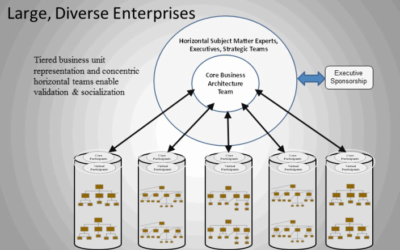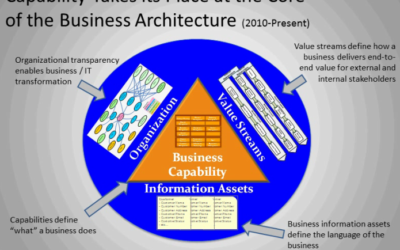A recently published article entitled “Business Capability Architecture Is the Tie that Binds All” discussed how to use business capabilities to tie business strategy, enterprise change, and project portfolio prioritization. We concur that strategy, enterprise change, and portfolio management are managed more effectively using business architecture, and agree that capabilities are a component of business architecture. However, we view the article’s notion of “business capability architecture” as being incomplete. We will discuss why this concept is incomplete and how it can be extended through value mapping.
Articles by: William Ulrich
Business-Driven Transformation Strategies & Roadmaps
Transformation roadmaps in many businesses tend to have a heavy technology focus, to the point where organizations invest millions of dollars in initiatives with no clear business value. In addition, numerous tactical projects are funded each year with little understanding of how, or even if, they align from a business perspective. Senior management often falls victim to the latest technology buzzwords, while stakeholder value, business issues and strategic considerations take a backseat. When this happens, executives who should be focused on business scenarios to improve stakeholder value fall victim to technology’s promise of the next big thing. This article discusses how executives can leverage business architecture to reclaim their ability to drive a comprehensive transformation strategy and roadmap.
Business Architecture & the Role of the CIO
I get a chance to work with CIOs in various capacities that usually involve major business challenges their organizations are facing and how IT can collaborate with business to address those challenges. These discussions are generally a precursor or follow-up to a strategic assessment, which tends to surface the expected technological challenges along with a few surprises. The surprise is not that IT has layer upon layer of fragmented, heavily redundant application and data architectures built on aging technology. This is unfortunately the norm. The surprise lies in why these problems keep multiplying and attempts to address them often turn into the next failed project. The fact is that issue analysis, problem definition, planning and funding all begin with the business and more often than not, these concerns lie behind a shroud of organizational siloes, fragmented customer perspectives and myriad business dialects.
Business Architecture: The Real Tie that Binds
By William Ulrich & Jim Rhyne
A recently published article entitled “Business Capability Architecture Is the Tie that Binds All” discussed how to use business capabilities to tie business strategy, enterprise change, and project portfolio prioritization.[i] We concur that strategy, enterprise change, and portfolio management are managed more effectively using business architecture, and agree that capabilities are a component of business architecture However we view the article’s notion of “business capability architecture” as being incomplete. We will discuss why this concept is incomplete and how it can be extended through value mapping.
Strategy Mapping and Business Architecture
At the Business Architecture Innovation Summit in Reston, VA this past March, a major challenge voiced by attendees was the difficulty they were experiencing in tying business strategy to business architecture. Because business strategy drives change, and business architecture enables change to become actionable, it follows that these two concepts should be closely aligned. But how does such alignment occur? The answer lies in ensuring that strategy mapping is adopted as an essential business architecture discipline that serves as the basis for integrating business goals, objectives and related action items into a comprehensive, business-driven perspective.
Deploying Business Strategy through Business Architecture
At the recent Business Architecture Innovation Summit in Reston, VA, one of the main challenges cited by attendees was the difficulty of aligning their business architecture with business strategy. While strategy mapping has historically been viewed as a standalone discipline, business architecture views strategy mapping as an integral component. Making your strategy actionable requires formalizing that strategy and aligning it to business architecture components that include capability, organization, value, information and initiatives. This article discusses strategy mapping frameworks and how to align those frameworks with related business architecture components to further prioritization, budgeting, portfolio planning and deployment.
Before we discuss how strategy mapping is incorporated into business architecture, let’s review a sampling of commonly used strategy mapping frameworks.
Business Architecture Takes Major Steps Toward Maturation
A year ago, I wrote a BA Bulletin article entitled “A Business Architecture Body of Knowledge.” In that article we examined the grassroots evolution of a body of knowledge and early signs of adoption. We spoke of selected success stories, business architecture as a worldwide phenomenon, the move towards business-driven business architecture and initial automation efforts. That article also discussed the rollout of release 1.0 of “A Guide to the Business Architecture Body of Knowledge” (BIZBOK™).[1] Since that time, business architecture has matured as a discipline and in practice, moving beyond simplistic discussions that were commonplace just a couple of years ago.
Capability Mapping – Part 2
Leveraging a Foundational Business Discipline
Capability mapping is commonly recognized as a business-oriented foundation for communication and collaboration, issue analysis and resolution, and prioritization and roadmap creation. Capability mapping is not hype and it is not an IT discipline. Rather it is a rapidly growing business practice that establishes a common business vocabulary that enables an organization to articulate an actionable vision, state a clear direction, focus investment priorities, address merger, acquisition, divestiture and outsourcing challenges, and focus technology investments on clearly articulated business demands. To begin leveraging this powerful discipline, attend this half-day workshop. The session will allow you to jumpstart or accelerate the mapping and use of business capabilities for a variety of business initiatives. Half-day workshop topics include:
Capability Mapping – Part 1
Leveraging a Foundational Business Discipline
Capability mapping is commonly recognized as a business-oriented foundation for communication and collaboration, issue analysis and resolution, and prioritization and roadmap creation. Capability mapping is not hype and it is not an IT discipline. Rather it is a rapidly growing business practice that establishes a common business vocabulary that enables an organization to articulate an actionable vision, state a clear direction, focus investment priorities, address merger, acquisition, divestiture and outsourcing challenges, and focus technology investments on clearly articulated business demands. To begin leveraging this powerful discipline, attend this half-day workshop. The session will allow you to jumpstart or accelerate the mapping and use of business capabilities for a variety of business initiatives. Half-day workshop topics include:
Business Architecture & Business Model Interpretation
A new trend in business strategy development involves viewing your business from the perspective of the “business model”. The business model provides templates for business executives to think about their costs and revenues, customers, channels and partners, and various activities and resources with a focus on maximizing profits and other measures of success.
























